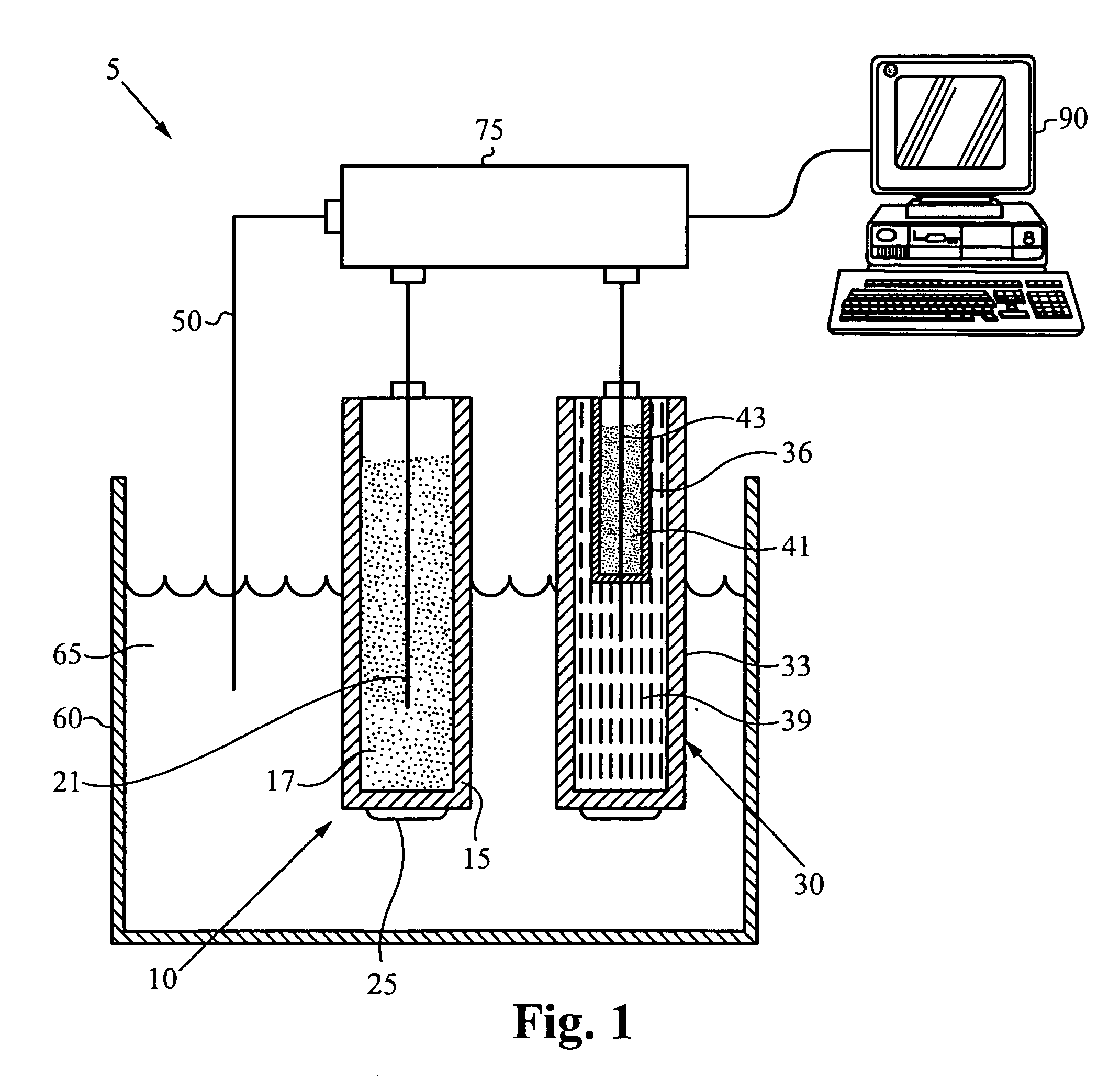Reversible electrochemical sensors for polyions
- Summary
- Abstract
- Description
- Claims
- Application Information
AI Technical Summary
Benefits of technology
Problems solved by technology
Method used
Image
Examples
example 1
Preparation of Protamine-Selective Membrane
[0119] The ability of a sensor incorporating a polyion-selective membrane according to the present invention to be used in an electrochemical cell was tested. A polycation-selective membrane was formulated, particularly to be selective for the polycation protamine. The membrane was formulated with 10 weight percent TDDA-DNNS in a 2:1 weight ratio mixture of 2-nitrophenyl octyl ether and polyvinyl chloride. The membrane was prepared by solvent casting with THF as the solvent. The mixture was allowed to dry into a film, and a protamine-selective membrane of about 200 μm thickness was prepared. The membrane was cut with a cork borer having a diameter of 6 mm to prepare membranes for incorporation into electrodes.
example 2
Preparation of Protamine-Selective Membrane Electrodes
[0120] The protamine-selective membranes prepared in Example 1 were incorporated into electrodes. The electrode comprised a Philips electrode body (IS-561), an inner reference solution of 0.1 M NaCl, and an electrode wire of Ag / AgCl. The protamine-selective membrane electrodes were conditioned overnight before experimental use in a solution identical to the inner reference solution.
[0121] A set of 10 identical electrodes were prepared as described above and tested for consistency in a 0.1 M NaCl solution prior to actual experimental use. Testing showed an inter-electrode variability of + / −7 mV (standard deviation) at a given current in the range of 0 to −10 μA.
[0122] The membrane electrodes were also tested to evaluate reversibility. The membrane was repeatedly exposed to two separate solutions, one containing 0.1 M NaCl, and one containing 0.1 M NaCl and 10 mg / L protamine. The same test was also performed using a prior art io...
example 3
Chronopotentiometric Responses for Samples with and without Protamine
[0123] A chronopotentiogram in 0.1 M NaCl with and without protamine was prepared. An electrochemical cell, such as that shown in FIG. 1, was set up using a protamine-selective membrane electrode as described in Example 2. The reference electrode was a double junction Ag / AgCl electrode with a 1 M LiOAc bridge electrolyte. The counter electrode was a platinum wire.
[0124] The voltammetric experiments were performed with an AFCBP1 Bipotentiostat (Pine Inst., Grove City, Pa.) controlled by a PCI-MIO-16E4 interface board and LabVIEW 5.0 Software (National Instruments, Austin, Tex.) on a Macintosh computer. Prior to the experiment the operation of the first electrode output of the bipotentiostat (K1) was switched to current control with potentiostatic control of output of the second working electrode (K2). In order to apply the current pulse, the working electrode was connected to the K1 output via an analog switch con...
PUM
| Property | Measurement | Unit |
|---|---|---|
| Thickness | aaaaa | aaaaa |
| Thickness | aaaaa | aaaaa |
| Thickness | aaaaa | aaaaa |
Abstract
Description
Claims
Application Information
 Login to View More
Login to View More - R&D
- Intellectual Property
- Life Sciences
- Materials
- Tech Scout
- Unparalleled Data Quality
- Higher Quality Content
- 60% Fewer Hallucinations
Browse by: Latest US Patents, China's latest patents, Technical Efficacy Thesaurus, Application Domain, Technology Topic, Popular Technical Reports.
© 2025 PatSnap. All rights reserved.Legal|Privacy policy|Modern Slavery Act Transparency Statement|Sitemap|About US| Contact US: help@patsnap.com



